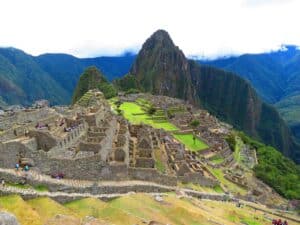Explore Unexplored Prospects In Peru With These 9 Important Reasons.
If you want to invest as an expat or high-net-worth individual, which is what i specialize in, you can email me (advice@adamfayed.com) or use WhatsApp (+44-7393-450-837).
Table of Contents
Introduction
Peru is now regarded as one of the world’s leading developing economies, with a significant recent history of economic stability, based on an average annual growth rate of 5.1 percent of GDP for the past 16 years, as well as people who stand out for their productivity and entrepreneurship. The factors that make Peru an ideal international investment destination.
1. A Country That Inspires Confidence
Despite political uncertainty during the recent change of government, Peru continues to have one of the lowest country risks in the Latin American area, earning the trust of foreign investors. Peru’s EMBIG (Emerging Market Bond Index Global) country risks yield averaged 1.83 percent, or 183 basis points, in August 2021, significantly lower than the regional average of 3.92 percent, or 392 basis points. Furthermore, throughout the first part of September, stated yield averaged less than 180 basis points. According to Peru’s Central Bank, Peru experienced the lowest country risk in the area in 2020.
Despite recent unrest in July 2021, Peru’s inflation rate remains among the lowest in the region, decreasing macroeconomic instability. Peru’s central bank increased the interest rate by 0.75 percent in August and September after maintaining it at 0.25 percent for a year. Although inflation has risen in Latin America’s largest economies in recent months, Peru still has one of the region’s lowest annual inflation rates, at 5.0 percent as of August 2021.
Peru has a two-decade track record of high growth, low inflation, and economic stability, allowing it to access international loan markets at extremely low rates. For the first time in Peruvian history, the government of Peru issued $4 billion in international bonds in November 2020, including some with 100-year maturities.
2. Peru Is Dedicated To Continuing To Invest In Human Capital Development
Peru is attempting to improve human capital on a continent where it is typically underestimated. In 2019, the World Economic Forum’s Global Talent Competitive Index (GTCI) classified it as one of the most improved countries, moving it up to 65th place out of 141 countries. Its increased investment and development of local talent helped it climb the corporate ladder.
3. A Country That Is Open To Foreign Trade
The Pacific-facing country was ranked 76th out of 190 economies in the World Bank Group’s Doing Business report in 2020. Peru has 21 active Free Trade Agreements, connecting it to 58 nations that account for 80% of global GDP and 40% of the world’s population. Peru has 28 bilateral investment treaties and nine double tax arrangements with other countries. It is a member of the World Trade Organization, the Asia-Pacific Economic Cooperation (APEC), and the Pacific Alliance, which includes Chile, Colombia, and Mexico.
Peru has four special economic zones that offer customs-free and tax-free protection to foreign-trade enterprises and services until 2042. The Pacific-facing ports of Tacna, Paita (in the Piura region), Ilo (in the Moquegua region), and Matarani are home to these zones (in the Arequipa region).
4. A Fantastic Environment In Which To Invest And Enjoy Life
Peru was #1 in Latin America in a 2019 Reputation Institute rating of countries with the best reputation in the globe before the pandemic. Peru was ranked 25th in the world, ahead of its Pacific Alliance trading allies Chile (28th), Colombia (48th), and Mexico (40th).
The country is also appealing to high-end guests who can enjoy unique experiences such as a desert picnic, an Amazon River cruise, or a hike along the Inca Trail. The Belmond Andean Explorer lines offer luxury train travel with amazing vistas, making it a first-class method for investors and their representatives to experience the nation.
High-end tourists, defined as those who arrive at Lima’s Jorge Chavez airport with a tour operator and spend more than $4,000 during their stay, accounted for 1.9 percent of Peru’s visitors in 2019, or 50,909 persons. Peru’s burgeoning reputation for gastronomy and as a gastronomic haven led to it being named the world’s top culinary destination for the eighth time in the World Travel Awards in 2019. Some of the world’s best restaurants can be found in Lima, including Astrid y Gastón, the iconic restaurant of Gastón Acurio, the renowned chef who established Peru as a gastronomic powerhouse, and Maido, a Japanese-Peruvian fusion restaurant under chef Mitsuharu Tsumura, which was voted Latin America’s Best Restaurant in 2019, 2018, and 2017.
5. Peru Has An Advantageous Business Environment
Setting up a business in Peru and obtaining legal protection for that business is reasonably simple for a foreign investor or entrepreneur. The right to freedom of enterprise is protected by Peruvian law. As a result, Peruvians and foreigners alike can engage in any legal activity as long as it does not jeopardise public health, national security, or environmental preservation. This right is guaranteed by Legislative Decree 662, the Foreign Investment Regime, which states that foreign investors are legally protected to operate in the country and have the same rights as citizens.
Similarly, Legislative Decree 757 defines the Legal Framework for the Growth of Private Investment, which includes specific legal security criteria. It stipulates that in all fields of economic activity and in any organisational or contractual form, free initiative and investment are guaranteed.
Peruvian legislation has also included tax incentives, such as a law enacted in 2019 (103309) that decreases income tax by up to 215 percent for investments in research, development, and innovation projects.
According to the FDI benchmark in March 2021, Peru is the regional leader in terms of efficiency in registering business ownership, taking an average of 7.5 days compared to the Latin American average of 41.5 days. It was also classified as the third cheapest country in the area to start a business, with a cost of $591 compared to an average of $1,166 in Argentina, Bolivia, Brazil, Chile, Colombia, Ecuador, Paraguay, and Uruguay.
Peru was ranked fourth, below average, for the number of procedures required to start a corporation, with eight compared to the regional average of 9.1.

6. A Country With A Business-Friendly Mentality
The Peruvian entrepreneur is one of the world’s youngest, with an average age of 24. In the 2018 Global Entrepreneurship Index, it was placed 67th out of 137 countries. According to the index, Peru is making efforts in technology absorption, and it is comparable to the Netherlands in terms of human capital and to Norway in terms of networking based on economic activity statistics.
7. A Nation Whose Economy Is Influenced By Global Digital Trends
In terms of internet access and trade, Peru is ahead of other countries in the region. It is one of the countries in the area with the most internet users, ranking fifth with 24 million users, ahead of Chile, Ecuador, and Guatemala. According to the market research portal Statista 2020, it also ranks fifth in terms of internet penetration, ahead of Brazil, Colombia, Bolivia, and Panama.
In the 2019 Global Connectivity ranking, Peru was rated 56th, ahead of Ecuador, Venezuela, Paraguay, and Bolivia. It climbed to 69th place in the 2019 Global Innovation Index, outperforming Argentina, Panama, Paraguay, and Ecuador, as well as other countries in the area. Peru is also one of just two countries in the region with higher innovation inputs than the regional average.
Peru rose 46 places in the UN’s digital engagement index in 2019 and was ranked 55th in the E-Participation Index. Peru ranked 71st out of 193 nations in the United Nations’ E-Government Development Index in 2020.
According to CAPECE, the Peruvian chamber of electronic commerce, more than three quarters (76.2%) of Peruvian houses have internet, 36.1 percent of Peruvians are online purchasers, and 78 percent have smartphones. According to CAPECE, internet retail consumption increased by more than 250 percent in 2020 compared to 2019. According to a Neo Consulting E-commerce survey from 2021, electronic sales in Peru increased by 86.7 percent between 2020 and 2021, far more than in other South American countries (E-commerce in Brazil grew by 60.9 percent , in Colombia by 53.1 percent , in Chile by 45.6 percent , and in Argentina by 39 percent ). Peru has been a regional leader in e-commerce, with a 35 percent average annual growth rate in the ten years prior to the Covid-19 pandemic. E-commerce will be valued $6 billion by the year 2020.
8. As A Result, Peru Has Become A Popular Foreign Direct Investment Location
Because of its favourable legislative and fiscal structure and vibrant industries, Peru is the fourth recipient of FDI in Latin America, behind Brazil, Colombia, and Chile. In recent years, it has been able to attract fresh investment. Spain is the country’s top investor, followed by the rest of the European Union, the United States, and the United Kingdom. Major investors include Chile, Brazil, and the Netherlands. Mining, communications, industry, finance, and energy are the industries that have drawn the most FDI.
Peru was similarly hit by the COVID-19 repercussions, which reduced global foreign direct investment (FDI) flows by 38% in 2020. According to the UNCTAD 2020 World Investment Report, FDI flows into the country surged by 37.1 percent from USD 6.5 billion to USD 8.9 billion between 2018 and 2019. The Central Bank of Peru, on the other hand, forecasts FDI flows of USD 1.5 billion in 2020 and USD 2.4 billion in 2021. At the end of 2019, the overall stock of FDI was USD 115 billion.
Peru has had consistent GDP growth during the last two decades, often outpacing global and regional averages. Following the implementation of COVID-19, prominent multilateral institutions predict that Peru will have the greatest growth rate in South America in 2021 and 2022, and the second highest growth rate in 2023.
9. How Does Peru Appeal To Foreign Direct Investment
According to the Central Bank of Peru, foreign direct investment increased to $80.8 billion between 2010 and 2019. Peru received $8.89 billion in foreign direct investment in 2019, making it the second-fastest-growing economy in the region. Peru received 410 FDI projects in manufacturing, tourism, and textiles over the same nine-year period. After manufacturing, this is the industry that has created the most jobs. Renewable energy came out on top in terms of future investment potential, followed by retail, which also provides a large number of employment. These projects together totaled $15.34 billion in investment and 86,329 jobs. According to fDi Markets data in 2021, the countries with the most capital invested in Peru were Spain with $1.2 billion (39%), China with $726 million (23%), Panamá with $504 million (16%), Chile with $263 million (8%), and Thailand in fifth place with $125 million (4%) between January 2019 and September 2020.
Natural resource potential (27 percent), strong internal demand (27 percent), and a macroeconomic climate conducive to growth (22 percent) were the main drivers of international investment interest in Peru between 2010 and 2019, according to the same 2021 survey by fDi Markets.
Pained by financial indecision? Want to invest with Adam?

Adam is an internationally recognised author on financial matters, with over 760.2 million answer views on Quora.com, a widely sold book on Amazon, and a contributor on Forbes.



